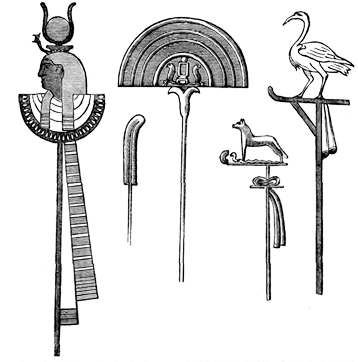
Flags are Fun . . . and Constantly Evolving
Sheldon Cooper from Big Bang Theory always tried to convince viewers that Flags Are Fun. But was he right? Since we didn’t know much about flags—except for the U.S. flag often seen flying above c-stores—we thought we’d take a closer look. So let’s start with:
Why were flags invented in the first place?
Well, it was thousands of years ago, and ancient Greek historians[1] tell us that flag-like standards called vexilloids were created by the Egyptians back even before the Pharaohs. Egypt’s regional divisions were called nomes back then, and there were 42 of them. Vexilloids were used to distinguish one from another. Take a look:

Now since this post is about flags, you’ll probably notice one key thing missing from the above: cloth. That’s because the right kind of material for flags didn’t exist yet. It took another thousand years for it to happen in China, where silk was invented around 2700 BCE. Silk was kept secret for a long time after that, and it took until about 200 A.D. for it to become available outside the country. That’s really when it became possible for the modern concept of flags to take form and spread, first to the Middle East, and then across Europe, all the way up to the land of the ice and snow.
In those early days, the primary use of flags was to identify troops on the battlefield, but houses of royalty found them useful in no time, as a kind of “brand” for their individual kingdoms. The advent of natural and synthetic fibers not only hastened the use of flags beyond military and political use, but added to their variety.
So even though we mainly think of flags as identifiers of countries, and rightly so, they’re weaved into everyday life more deeply than that: basically, when someone wants to call attention to something. Retailers embrace flags as a promotional tool, and c-stores have been among the most proactive in embracing the concept as it has changed over time.
The traditional analog appeal of a flag flying on a pole is still in fashion. We’ve mentioned the popular sight of the American flag flying over c-stores nationwide, which can be a marketing tool in its own right. Plenty of c-stores fly flags with their own brand on them, often making them available for purchase to consumers.
But the flag has evolved further—and so has its appeal to c-store retailers. Take the feather flag, for example, a cut down, colorful version that stands on the ground and doesn’t take up much space. These are often used to highlight merchandise, like “propane” or “lottery.”[2]
One of the most interesting things that we found, as we did research for this post, was that more and more gas stations and convenience stores, as well as the media that cover them, have begun to refer to the logo and brand images displaying on a retailer’s building and forecourt as brand flags. It’s an example where the c-store industry has had an influence on common-use terminology, broadening it.
The industry has also long embraced the use of digital signage, and it isn’t too much of a stretch to view the technology as just another step forward in the development of the flag. Will we still use that simple, one word term when immersive VR[3] marketing becomes all the rage? Only time will tell.
Flags have become so ingrained in our lives as a means of calling attention to something important, that the word for doing so is now called “flagging.”
Of course, the act of flagging is only useful when its intention is clear, and its delivery is timely. Fortunately, that’s exactly the kind of flagging that SSCS’s Computerized Daily Book (CDB) provides for c-stores. Over/Short unacceptable? Fast moving stock getting low? Too many voids at the register? Margins slipping?
These are only a few of the alerts that the CDB software can bring to your attention, keeping your business within the parameters you need to succeed. Looking to get a handle on your issues before they become more severe? Give us a call at (800) 972-7277 and we’ll provide the details.
[1] Cited in Wikipedia “Flag” entry.
[2] A step away, but a significant one, from the ever popular, Sky Dancer.
[3] Virtual Reality, of the immersive type.






Leave A Comment